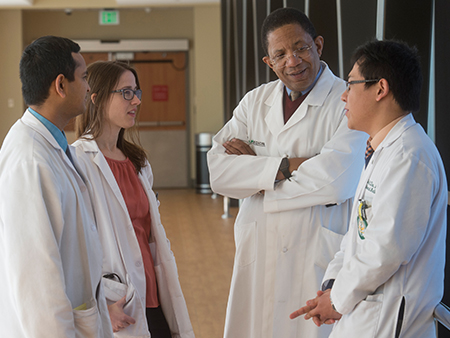
 By any measure, it is remarkable growth.
By any measure, it is remarkable growth.
In the past five years, the University of Alabama at Birmingham School of Medicine has climbed 10 places on the National Institutes of Health research funding rankings, from 31 in the nation to 21. Total NIH funding during that period rose from $133,264,288 in 2013 to $234,390,799 in 2018. The story of how Alabama’s flagship medical school came to be standing on the doorstep of the 20 top-funded schools in the nation is one of commitment, vision and hard work.
“Over the past five years, UAB has been part of an elite group of eight academic medical centers that have experienced more than $100 million in net NIH funding growth,” said Selwyn Vickers, M.D., senior vice president and dean of the medical school. “We enjoyed the second-highest percent of growth — 43 percent — only scant percentage points behind the leader, Northwestern University. This growth is attributable to an incredible collaborative effort from University and Health System leadership down to the work done every day at every level of our institution.”
Leaders in the School of Medicine point to a systematic plan initiated following the arrival of Vickers as dean in 2013 to boost NIH funding by concentrating on several key components.
“The growth we have experienced over the past several years has been drawn from several factors,” said Robert Kimberly, M.D., senior associate dean for Clinical and Translational Research. “It required and received full engagement from the faculty. We’ve enjoyed the full support of the Health System to achieve the goals we’ve laid out. And we’ve launched a major effort to help faculty successfully compete for grants in what is a remarkably competitive environment.”
Science through synergy
One way to quickly move up in funding rankings is to secure large, collaborative grants, and UAB has seen success in that arena. The NIH provided $45 million to UAB to lead the Southern Network of the All of Us Research Program, a national effort to encourage and promote genomic medicine. Other large grants were awarded to the Center for Clinical and Translational Science, the Center for AIDS Research, the Antivirial Drug Discovery and Development Center, and the O’Neal Comprehensive Cancer Center.
“The All of Us grant is a great example of the pathway NIH is following toward large, multidisciplinary, collaborative grants,” Kimberly said. “It is incumbent on us to help our researchers work together to apply for, and secure, those types of grants. I like to say it is science through synergy.”
A program launched in 2015, called the Multi-PI Program, fosters collaboration by creating a funding mechanism to encourage faculty to work with researchers in other disciplines on a common goal. The SOM funded four collaborative projects in 2015 with substantial seed money. The research teams were able to produce significant preliminary results and jointly publish that data, priming the pump for securing large, collaborative NIH grants.
“The intent is to fund a cadre of faculty, both basic science and clinical researchers, who have complementary research interests,” said Etty (Tika) Benveniste, Ph.D., senior vice dean for Basic Sciences. “The first four we funded were successful at leveraging our initial investment into larger NIH grants. We have funded eight more since then, with more in the pipeline.”
The return on investment for the initial round of funding was 19 to 1, says Benveniste.
“A small investment by the school on the front end often results in a much larger return on the back end in the guise of multiyear NIH funds,” she said.
One grant is good. Two grants is better.
An additional target firmly in leadership’s crosshairs is the bread and butter of NIH funding — the R01 grant.
“Most faculty have an R01 grant,” Benveniste said. “These are the primary funding sources to establish and equip a laboratory. So, a target for growth is to help an investigator get a second R01 grant.”
In 2016, the school launched a mechanism to achieve this goal, with internal funding available to allow investigators to do the necessary preliminary studies and acquire the data needed to apply for a second R01. Eleven investigators were funded in 2016, with a grant of $50,000 per year for two years. Five more received funding in 2017 and six in 2018.
“Those funded in 2016 have been largely successful,” Benveniste said. “They are wrapping up now, and the investigators are now using their newly acquired data to apply for new, additional R01 grants. So far, the return on investment for this initiative is 16 to 1.”
Along with seed money, the SOM has provided bridge funds drawn from state investment in UAB to help researchers keep their labs and their important projects going while in the midst of the sometimes lengthy NIH funding process. More than 40 faculty have received bridge funding since 2015, and the majority, more than 70 percent, have ultimately secured NIH funding ensuring long-term viability.
 The clinical side steps up
The clinical side steps up
Recognizing the importance of seed funding, the school created the Academic Enrichment Fund to provide the necessary resources in 2014.
“The fund was created with the support of the clinical enterprise of UAB Medicine, from UAB Health System CEO Dr. Will Ferniany and Health System leadership, UAB Hospital, and the clinical chairs,” Kimberly said. “These are resources contributed by the Health System that the dean can tap for pilot studies, seed funding or recruitment efforts. These funds are central to our ability to compete on a national stage for the NIH grants that can be transformative, not just for UAB, but for the people of our communities.”
“That, of course, is the ultimate goal,” said Anupam Agarwal, M.D., executive vice dean of the SOM. “Can we, through science, make a meaningful difference in the lives of the people of Alabama and our region? Many of these NIH grants target key diseases in our state — diabetes, cancer, kidney disease, obesity. These diseases are a huge burden in Alabama, and we need to target our research to find the needed treatments, not to see our rank increase, but to provide answers to the most problematic diseases affecting our population.”
More scientists, more dollars
Another strategy to boost the number of research dollars coming into the university is to boost the number of researchers at the university. That can mean attracting new faculty, and hanging onto the ones already here.
“Recruitment of new faculty brings in new grants and also new energy,” Kimberly said. “It builds capacity and creates an atmosphere of competitiveness that is healthy. But part of growing is enabling current faculty to be successful as well. Both pieces are important.”
And the faculty is growing. The number of principal investigators at UAB has climbed from 259 five years ago to 323 at the start of 2019, an increase of nearly 25 percent.
“The older, more established medical schools at the top of the NIH funding list have more faculty than we do, so it stands to reason that they pull in more research dollars,” Agarwal said.
“But we’re growing. For example, five years ago the Department of Medicine had just five Career Development Awards, called K-awards, from NIH. Now we stand at 29.”
“Our growth has been in both the clinical sciences and the basic sciences,” Benveniste said. “We understand that basic science is the foundation that leads ultimately to the translation of an idea to a meaningful therapy. All of this effort is an investment in our faculty so that we enhance their ability to succeed and to help spur our overall growth.”
Sharpening the science
Kimberly points to another program, housed in the Center for Clinical and Translational Science, that helps a researcher fine-tune their plans, projects and approach.
“The idea is to sharpen the science,” Kimberly said. “Investigators can bring their research hypothesis to CCTS, and we organize a panel of peers to review the idea and offer feedback and advice, on anything from goals and aims to methodology or how to connect with potential research partners across campus.”
CCTS has enabled 260 panels since 2017, and Kimberly says investigators who have taken advantage of the program have a success rate in garnering NIH grants that is four times that of the national success rate.
UAB’s investment in new burgeoning fields in medicine is also paying dividends. The Hugh Kaul Precision Medicine Institute, the Informatics Institute, Proton Therapy Center and the UAB-HudsonAlpha Center for Genomic Medicine are cutting-edge programs in cutting-edge fields. All present opportunities for researchers to expand their horizons and make exciting new discoveries.
“These are innovative research efforts that will benefit the people of Alabama,” Kimberly said. “Our work can have tremendous effect on the diseases faced by our citizens.”
The future
“We are on a path that we believe will continue to support sustainable growth,” Agarwal said. “We are currently 21st in NIH funding, and we anticipate moving to somewhere between 15th and 20th over the next three years. We need to have at least 10 departments within the top 10 in their field. We have six now, so we have room to grow. And work to do.”
Agarwal says continued funding growth is critical for every pillar of AMC 21, the Health System and School of Medicine’s strategic plan to be the preferred academic health center of the 21st century.
“The top-funded institutions are also the ones consistently rated at the top in patient care,” he said. “Research schools ranked highly also house the best patient care hospitals (as ranked by U.S. News & World Report). Our faculty have worked very hard to get to where we are today, and it has been a total team effort. We are at an exciting milestone, but we have more to accomplish. Fortunately, we have the tools and the will to keep our momentum going forward.”
 A rising tide
A rising tide
The School of Medicine does not operate in a vacuum. UAB has enjoyed a heady stream of accomplishments that have touched every facet of the university. Overall research funding to UAB topped $500 million in 2018, and the university just completed its largest fundraising campaign ever — a $30 million naming gift for the O’Neal Comprehensive Cancer Center put the Campaign for UAB over $1 billion. Total NIH funding to all schools within UAB reached nearly $300 million.
“Each entity at UAB builds off the efforts, accomplishments and successes of our colleagues and peers across this great university,” Vickers said. “Each of the other schools that compete for NIH funding ranked highly among its peer institutions — the Schools of Dentistry and Optometry each ranked fourth in its field, and the other schools were in the top 20 in research funding.
It is the collaborative spirit of UAB that builds partnerships across campus, and the success of each school, institute and center helps us all reach our individual and collective goals.”
“I like to say that our true competition is the diseases we fight and the challenges we face,” Kimberly said. “If we are going to look at it in terms of winning and losing, I think we win when we enhance our leadership in the region, through our mission, collaboration with our peers and commitment to finding solutions to the medical problems that plague humankind. When we do those things, all else follows. The grants will follow.”